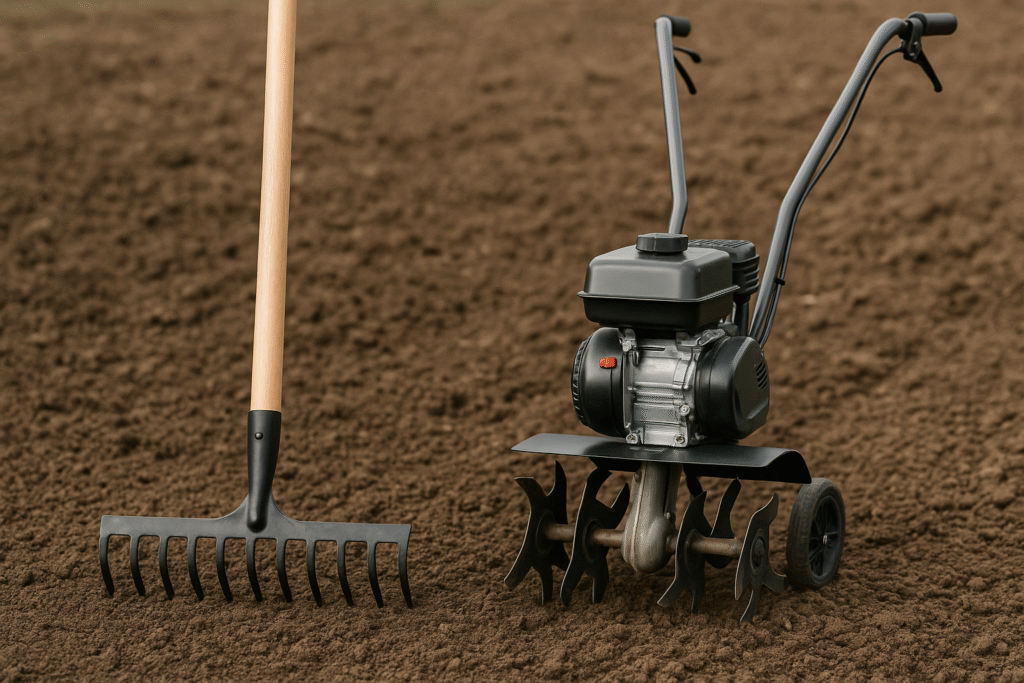
Garden Rakes vs. Rotary Hoes: Which Tool Does What, When, and Why It Matters for Your Garden
Whether you have got a tiny urban courtyard or a sprawling rural veggie garden, one question eventually pops up: Do I need a garden rake, a rotary hoe, or both?
Both tools are designed to help you prepare and maintain your soil, but they serve very different purposes. Knowing when and why to use each one not only saves time and effort — it can also help your plants thrive.
In this post, we’ll break down the differences between garden rakes and rotary hoes, what each is used for, the best times of year to use them, and why garden rakes still hold a special place in every gardener’s shed.
Understanding the Tools
Garden Rakes
A garden rake is a manual tool with strong, rigid tines (often made of metal) arranged in a straight line along a horizontal bar. It’s designed to be pulled across the soil surface to move, level, or loosen material. Garden rakes are sometimes called “soil rakes” or “bow rakes” — not to be confused with leaf rakes, which have wide, flexible tines for gathering leaves.
Common uses include:
- Breaking up surface clods of soil
- Leveling seedbeds before planting
- Spreading mulch or compost evenly
- Removing stones or debris from soil
Key benefits:
- Offers precision and control
- Lightweight and easy to store
- Affordable and long-lasting
Rotary Hoes
A rotary hoe (or rotary tiller) is a powered gardening tool with rotating tines or blades designed to break up and turn over soil. Rotary hoes come in petrol and electric versions, and their size can range from small electric models for home gardens to large petrol machines for big veggie patches or farm plots.
Common uses include:
- Tilling compacted soil before planting
- Incorporating compost or fertiliser into the soil
- Breaking new ground for a garden bed
- Preparing soil for large-scale planting
Key benefits:
- Saves time and physical effort for larger areas
- Can work deeper into the soil than a rake
- Ideal for mixing in organic matter evenly
When to Use Each
The main difference between these tools comes down to scale, soil condition, and timing.
- Use a garden rake when your soil is already loose and workable, and you just need to smooth, level, or remove debris.
- Use a rotary hoe when you need to break up compacted soil, prepare a new garden bed, or work organic matter into the soil deeply.
Want to explore the top machines for the job? Check out our guide to The Best Petrol and Electric Rotary Hoes for Your Urban and Rural Veggie Garden for detailed reviews and tips.
Seasonal Use Guide
Spring
- Rotary hoes are perfect for breaking up winter-compacted soil and mixing in compost or fertiliser.
- Garden rakes are ideal for creating smooth seedbeds and removing leftover debris before planting.
Summer
- Rakes can help maintain beds by smoothing soil after harvesting and lightly aerating areas without disturbing plant roots.
- Rotary hoes are less commonly used mid-season unless you are starting a new bed for fast-growing summer crops.
Autumn
- Rotary hoes can incorporate organic matter, manure, or green manure crops into the soil before winter.
- Garden rakes are perfect for spreading mulch and tidying beds before the colder months.
Winter
- Rotary hoes are typically stored away, as frozen or waterlogged soils are not suitable for tilling.
- Garden rakes may still see use in mild climates for compost spreading or winter clean-up.
Why Garden Rakes Still Have a Place in Every Shed
Even in an age of powered tools, garden rakes are irreplaceable. They’re simple, affordable, and precise. Unlike a rotary hoe, which is overkill for fine surface work, a rake allows you to gently shape and prepare the top layer of soil without churning it too deeply. This is especially important for delicate seedlings and shallow-rooted plants.
A good rake can last decades with minimal care, and it’s one of the few garden tools that work just as well in a city balcony planter as it does in a country vegetable patch.
Pros and Cons at a Glance
| Tool | Pros | Cons |
| Garden Rake | Precise, lightweight, inexpensive, low-maintenance | Requires physical effort for large areas |
| Rotary Hoe | Fast, deep tilling, great for large or compacted areas | Can be heavy, expensive, and overkill for small jobs |
The Bottom Line
If you have limited space or already-loose soil, you can get by with a garden rake for most tasks. See also our follow up post about the 5 best garden rakes in 2025. But if you’re breaking ground, rejuvenating neglected plots, or preparing large vegetable beds, a rotary hoe will save you hours of work and give you a better tilth for planting. For most gardeners — rural or urban — the best solution is having both. Use the rotary hoe for big seasonal tasks and the rake for the finer finishing work.
